The modern Armenian state has survived many conflicts with hostile neighbors. While tiny, it is the inheritor of a national history that once stretched from the Mediterranean to the Caspian Sea. But today, after losing a war with Azerbaijan, the country is on Russian life support, and time is running out on what little independence it has left. Having tried to remove Armenia from Russia’s sphere of influence, Prime Minister Nikol Pashinyan has ironically made it the most subservient to Russia it’s ever been since the country was released from Soviet rule. With a weak military and political leadership, Armenia is faced with a tough choice: to become a vassal of Russia, or else be left to face Turkey and Azerbaijan alone.
In November 2020, I began a three-week journey documenting the aftermath of Armenia’s conflict with Azerbaijan, and recently returned to the country to continue reporting on its precarious and uncertain future. The war was fought over the disputed mountainous region of Nagorno-Karabakh and several surrounding territories. It ended in Armenia’s near-total defeat, with a Russian-brokered peace deal finalized on November 9th. I spent four days visiting the region itself, in what is left of the independent Republic of Artsakh, an ethnic Armenian breakaway state which is claimed by Azerbaijan. But the peace deal is fragile, and many expect another war.
Armenians were shocked to find out just how incredibly unfavorable the November peace deal was. Armenia relinquished control of the seven provinces it had gained in the 1990s, as well as the strategically and culturally important city of Shushi, the region of Kelbajar which hosts the historic Armenian Dadivank Monastery, and other Armenian enclaves like Hadrut. What little territory Armenia was able to retain from the contested regions is being guarded—and, more accurately, controlled—by Russia. The Armenian military’s reliance on weapons and training from the Soviet era, combined with the neglect of the armed forces by successive governments, ensured their defeat.
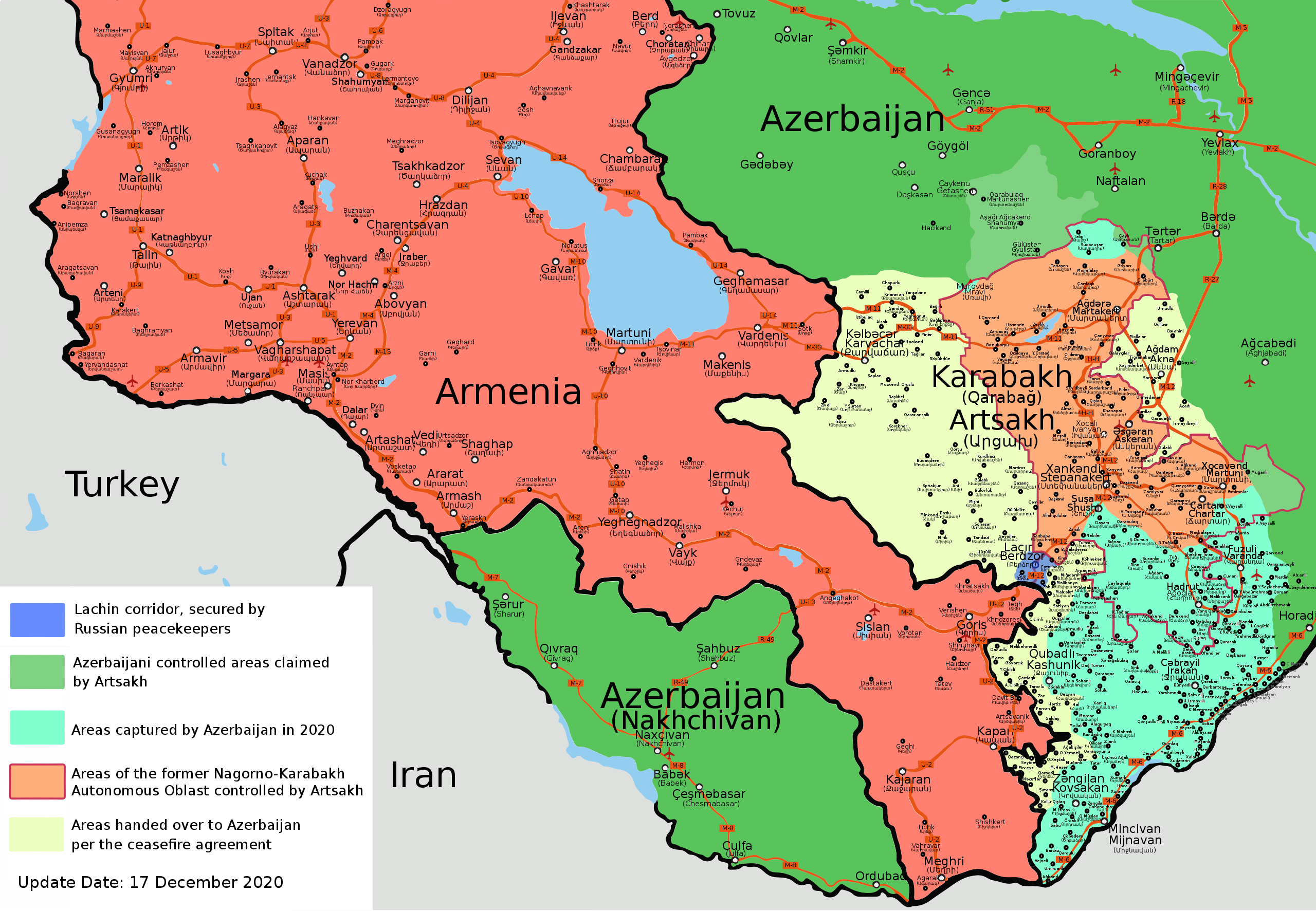
My trip began with a rocky and inhospitable start. I was pulled aside at customs and had my passport confiscated because my visa hadn’t yet been approved. Several Armenian military and customs officials looked over me, then my passport, and then at each other, discussing what to do with this foreigner whom “no one invited to Armenia.” I was directed upstairs to an empty terminal where I spent the night, seemingly the only one in the entire place. After a frantic and sleepless night, my visa turned up approved around 9 AM. Having finally cleared customs, it was time to make my way towards Yerevan.
As I was leaving the airport, I was immediately solicited by the large numbers of cabbies milling about the area. Around $4 (or 2000 Dram) easily gets you across the entire city in full traffic. Armenia is an extremely poor country, with a GDP per capita of only around $4600 USD. For my part, I already had a ride. But explaining this was difficult—the Armenian language is one of the hardest on Earth to learn, with a completely independent alphabet and vocabulary.
As we approached downtown Yerevan, two police officers with AK-47’s were conducting seemingly indiscriminate searches of cars, a precaution due to assassination threats that had recently been made against Armenia’s prime minister. On the night when Pashinyan signed Armenia’s surrender, protestors stormed the national assembly and seriously assaulted the speaker of the parliament. For the next few days, a coup or assassination seemed imminent. But Pashinyan and his government have thus far survived despite the pressure. By the time I arrived, the war had been over for three weeks, with Russian boots on the ground and Pashinyan showing no signs of stepping down. Since the war, a deep sense of betrayal and abandonment has gripped Armenia: its government surrendered, Russia failed to intervene early enough, and the Western world ignored their struggle. However, the country had largely accepted that there was no way to reverse the peace deal. Although anti-government demonstrations were still taking place daily at Republic Square, their attendance and intensity were steadily decreasing.
Nevertheless, these demonstrations seemed like a good place to start reporting, and so I headed to Republic Square on my first full day in Armenia. A thick line of police was blocking the door to the Government House building as a senior officer called out Armenian names. The names were those of family members of soldiers who were missing in action or prisoners of war. As each name was called, the police line broke to allow the families into the building. The government was giving them a long-awaited update on the fate of their sons, husbands, and fathers. Among the crowd of family members were protestors, including several men who had fought in the first Nagorno-Karabakh war in the 1990s. One man was highly decorated, displaying medals on his jacket and holding up a sign denouncing Pashinyan.

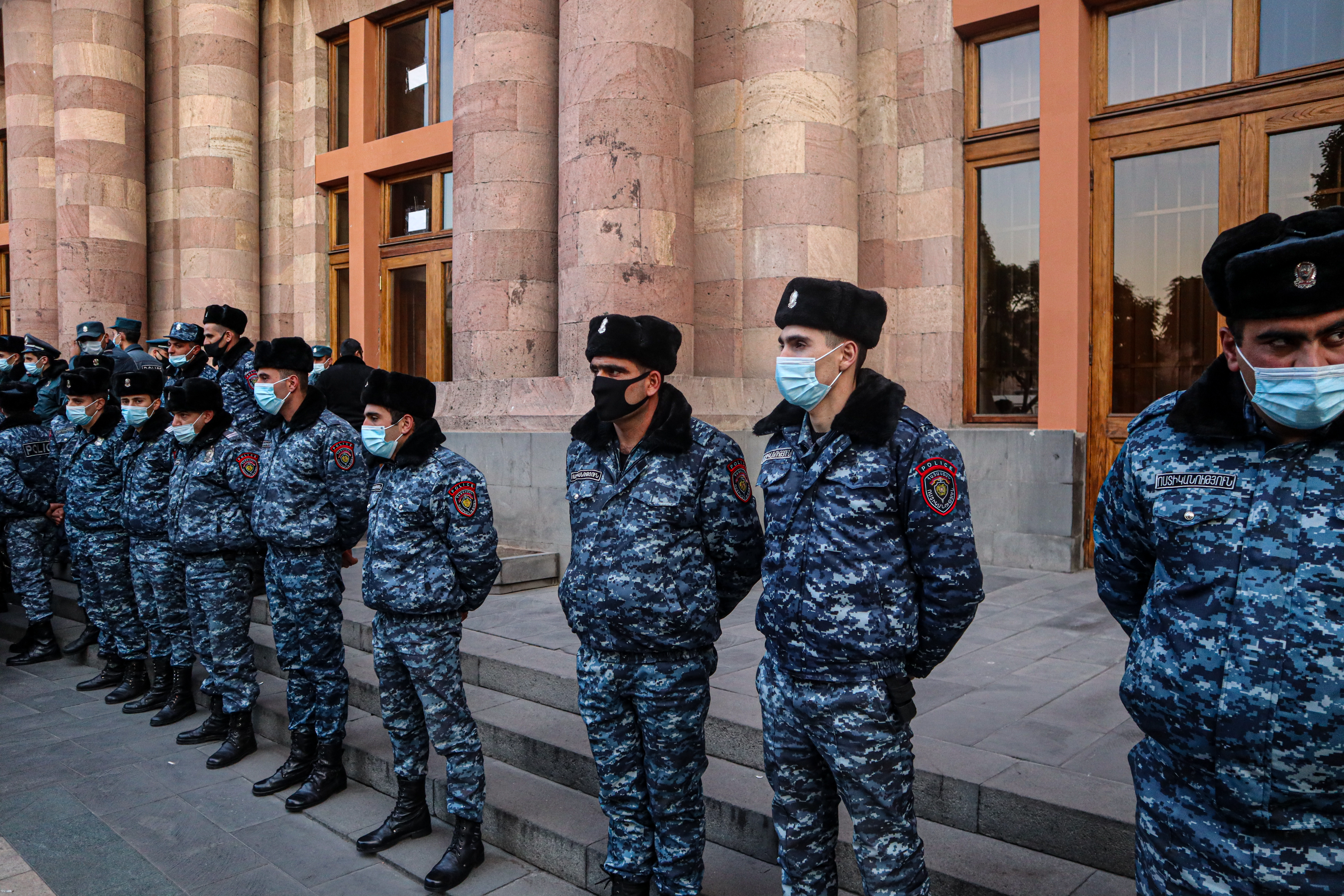
The Second Nagorno-Karabakh War
The major factor in Azerbaijan’s victory was its edge in military technology, with recent purchases of advanced weapons systems from Turkey, Israel, and Canada. More than previous conflicts, this war was a significant demonstration of the potential of many new types of combat robotics, particularly a new generation of military drones. The two main drones Azerbaijan has under commission are the Israeli Harop and Turkish Bayraktar TB2.
The other major technological difference between this war and that of the 1990s was a ubiquitous internet, which both sides have used to their advantage. Videos depicting Azerbaijani soldiers beheading, torturing, and otherwise mistreating Armenian prisoners have been circulating in private messaging platforms like Telegram, with censored versions presented to larger audiences on curated platforms like Instagram. Azerbaijan has emerged as a brutal leader in the production of these viral war videos. A smaller number of videos depicting Armenian war crimes also circle around Azerbaijan, but they pale in comparison in both quantity and ruthlessness to the Azerbaijani videos. It’s a trend noted by foreign reporters as well as domestic, and a bad omen for the brutality with which future conflicts will be fought.
Every Armenian who was waiting outside the government building that day to get an update on their missing family member had undoubtedly seen these videos or been made aware of them. Before the war in the 1990s, Armenians and Azeris lived together in relative peace in several regions, including in Nagorno-Karabakh and in Baku, the capital of Azerbaijan. Pre-internet, it was easier to move past the memory of war and for the victor to simply write history. Now, in contrast, the whole population is digitally participating at the front line, and directly witnessing the atrocities committed by the enemy, even from a diaspora neighborhood in Los Angeles or Toronto.
During the war, Armenians who were engaged on social media would be inundated with daily reports of deceased soldiers from diaspora outlets like Zartonk Media or The Armenian Report. The reports always included a long list of names followed by birth dates, typically ranging from around 1996 to 2002. Armenia’s military is young, and their training and preparation paled in comparison to the well-equipped military of Azerbaijan. Many Armenian men barely in their twenties found themselves in a leadership position after being conscripted to fight on the front line, responsible for leading 18-year-olds into battle. The result is that innumerable families have lost sons, brothers, and young husbands to the conflict. On January 28th, I visited Yerablur, Armenia’s main military graveyard, as crowds gathered to mourn the fallen on the country’s annual Army Day. A local friend led me through the graves and piles of flowers, pointing out the dates on the stones, as weeping families stood mourning around them.

While the mobilization of diaspora Armenians on social media has been successful insofar as it raises awareness about the conflict, Azerbaijan had the upper hand in the Western war of information and diplomacy. This was thanks to their use of growing oil wealth to develop geopolitical leverage and hard financial lobbying power in Western capitals, including Washington D.C. While the voices of diaspora Armenians were loud, they weren’t able to accomplish much more than garnering a few platitudes from Western politicians. Advocacy pales in comparison to lobbying and hard material incentives. Turkey has spent millions on sophisticated PR campaigns and developed a powerful propaganda machine, from soap operas to supportive front groups. Conversely, Armenia wasn’t organized or connected enough to gain the support of groups like Amnesty International and Human Rights Watch, nor that of most Western governments.
Along with its fleet of cutting-edge drones, Azerbaijan also showcased their military and diplomatic might by using the expensive and controversial chemical weapon white phosphorus. Before traveling to Nagorno-Karabakh, I spent several days accompanying a team of doctors in Yerevan’s hospitals as they treated soldiers for the horrific injuries caused by this munition. A large number of foreign doctors have traveled to Armenia to assist in the treatment of injured soldiers, bringing with them crucial medical supplies and aid. Without them, many more of these men would have died in Armenia’s ill-equipped healthcare system, and become casualties of the conflict. I was introduced by a mutual friend to the two most experienced burn surgeons in Yerevan at that time and joined them for lunch one day before I accompanied them to the hospitals.
As we sat in a Lebanese restaurant eating kebab, Dr. Fouad Reda recounted his story to me. He runs a private practice as an aesthetic reconstructive plastic surgeon in Yerevan, where he’s lived for two years since arriving from Lebanon. His cosmetic procedures were put on hold when war broke out and he quickly shifted to treating wounded soldiers. Then, Armenian hospitals began receiving a massive influx of burn patients from the front line. Joining us was his colleague Dr. Raffi Barsoumian, an Armenian-American burn surgeon from New Jersey who’d recently arrived in Yerevan to volunteer his services. “You wouldn’t find burn surgeons in the United States who have experience with something like this unless they had assisted other physicians in theatres of war,” Dr. Barsoumian explained. Dr. Reda himself, it turned out, was the first to discover that white phosphorus was the cause of these burns. I asked Dr. Reda about his own story. He had prior experience treating white phosphorus victims in Lebanon in 2006 and Syria in 2017. The two told me about the horrific injuries the substance creates. As we ate lunch, they negotiated the exchange of scarce medical supplies which they had acquired through international donations.
The next day, we made our way into the hospital ward. The sight was grim—many of the injured soldiers had second- and third-degree burns covering their entire bodies. Most had been in the hospital system for weeks, their deep wounds still needing to be frequently re-dressed and tended to. One of the soldiers I spoke with was 18 years old and had volunteered to fight when the war broke out on September 27th. In addition to his burns, he was shot twice by a sniper in his backside. His survival was miraculous. After the medical team finished working on his face and hand, his father explained to me that he was a boxer, and still hoped to get back to the sport when his time here was done. Fortunately for him, the wounds on his hand looked set to heal. Not everyone was so lucky. His friend, who lay in the bed across from him, was in much worse shape. Third-degree burns almost completely covered his entire back.
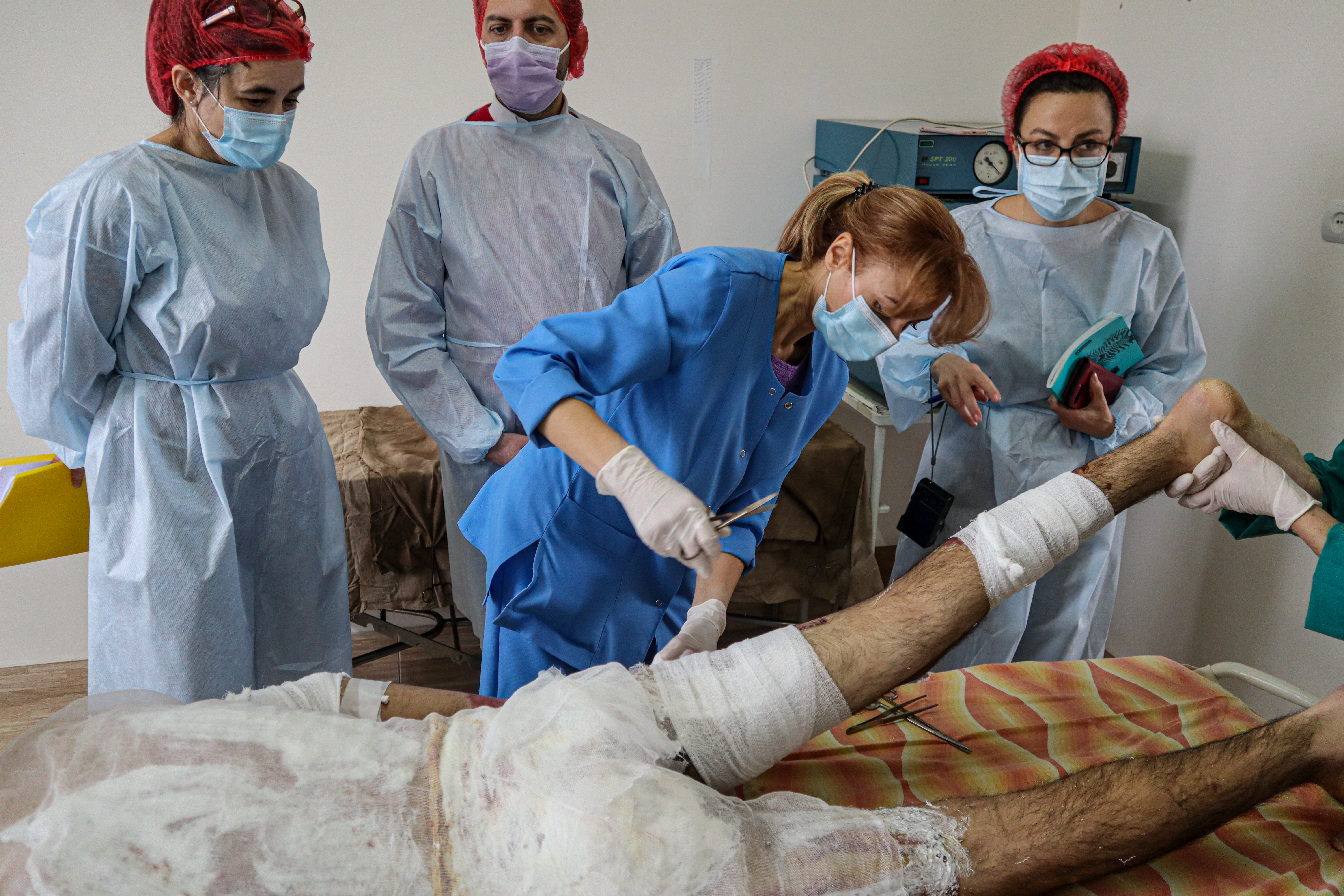
When the gruesome re-dressings were done, the boxer’s father brought refreshments for the two soldiers. Despite their injuries, both men’s faces lit up. As I photographed the moment, I wondered what the pair—barely of age—had seen together on the front line. The boxer’s father told me their story as they ate. As the war raged on and Armenia was pushed back into the forests to hide from Azerbaijan’s drones, the Azerbaijanis had launched white phosphorus attacks to burn away the brush and the soldiers hiding within. They had been caught in the attack.
White phosphorus is an extremely combustible and poisonous chemical weapon that has a complicated standing in international law. Despite the horrific injuries and the invariably indiscriminate way the weapon is used on the battlefield, its use is generally not considered to be a war crime unless it is used against civilians.
But white phosphorus is still controversial enough for Azerbaijan to deny using it in the war. Instead, they claim it was Armenia who was using the munition to obscure the vision of Azerbaijan’s drones. While these claims can’t be confirmed or denied, it’s unlikely that the Armenian military, which couldn’t even fund its own tiny air force, would have spent money on an expensive munition such as white phosphorus. But Azerbaijan had certainly been using it. I stood alongside medical staff as they treated approximately a dozen soldiers in Yerevan’s hospitals for phosphorus injuries. Chemical tests made its presence incontrovertible.
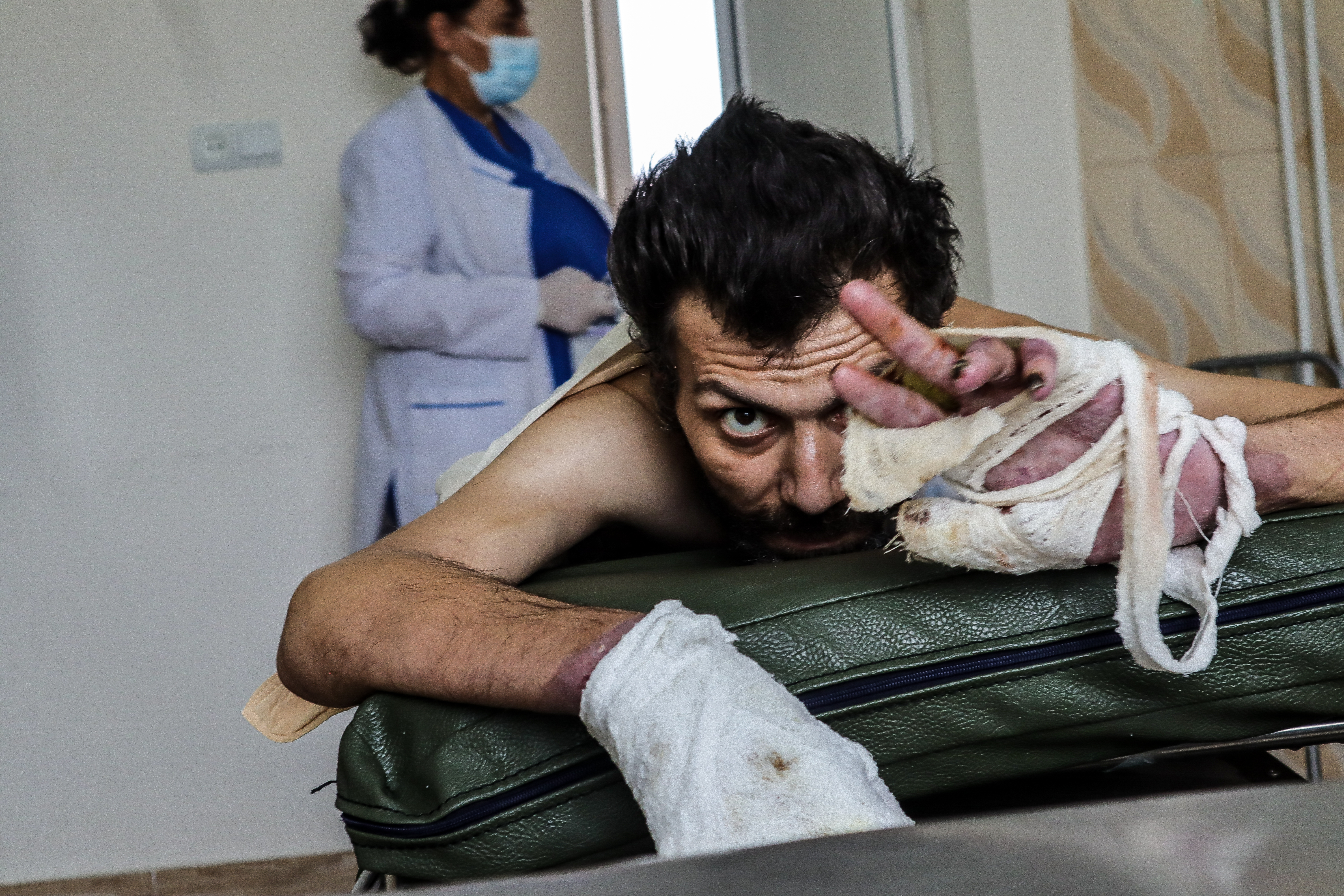
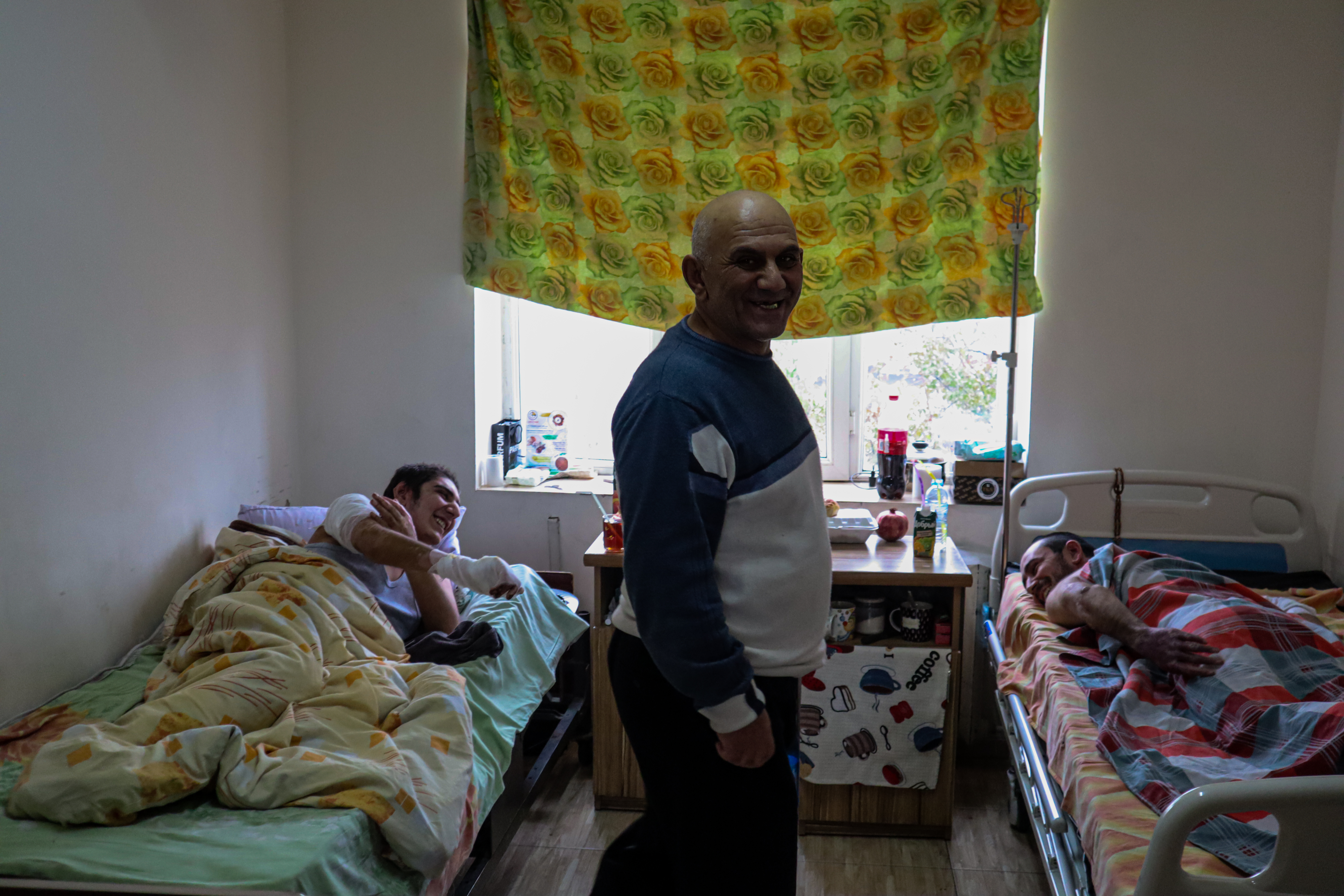
The Failure of the Diaspora and Armenia’s Westernization Strategy
The Davtashen National Burn Center of Armenia served as an example of just how important the diaspora remains for material aid. There was a group of about five doctors from France who had flown in to assist in whatever way they could, bringing with them several boxes of humanitarian aid. France is also an exception to the general sluggishness with which Western states have responded to diaspora pressure. With a 600,000 strong Armenian diaspora presence, France is one of Armenia’s closest Western allies, and a mediating member in the OSCE Minsk Group, an international body created to solve the crisis of the first Nagorno-Karabakh war. My flight from Toronto to Paris was virtually empty, thanks to the pandemic. But my flight from Paris to Yerevan was almost completely booked. Armenians from all around the world were traveling to repatriate, reconnect with family, and participate in Armenia’s recovery.
Both the French government and Armenians from the diaspora in France have sent a considerable amount of international aid. But Turkish membership in NATO ensures that even willing Western countries remain impotent when it comes to defense aid. Two weeks after the peace deal had been signed, the French senate decided to recognize the independence of Artsakh, to which Armenians with any sense exclaimed, “So what?” Still, it’s more than anyone expects from most other Western countries, including the U.S., which co-chairs the OSCE Minsk Group with France. Azerbaijan’s powerful lobbyists ensure a muted response to the conflict and a steady stream of friendly media articles.
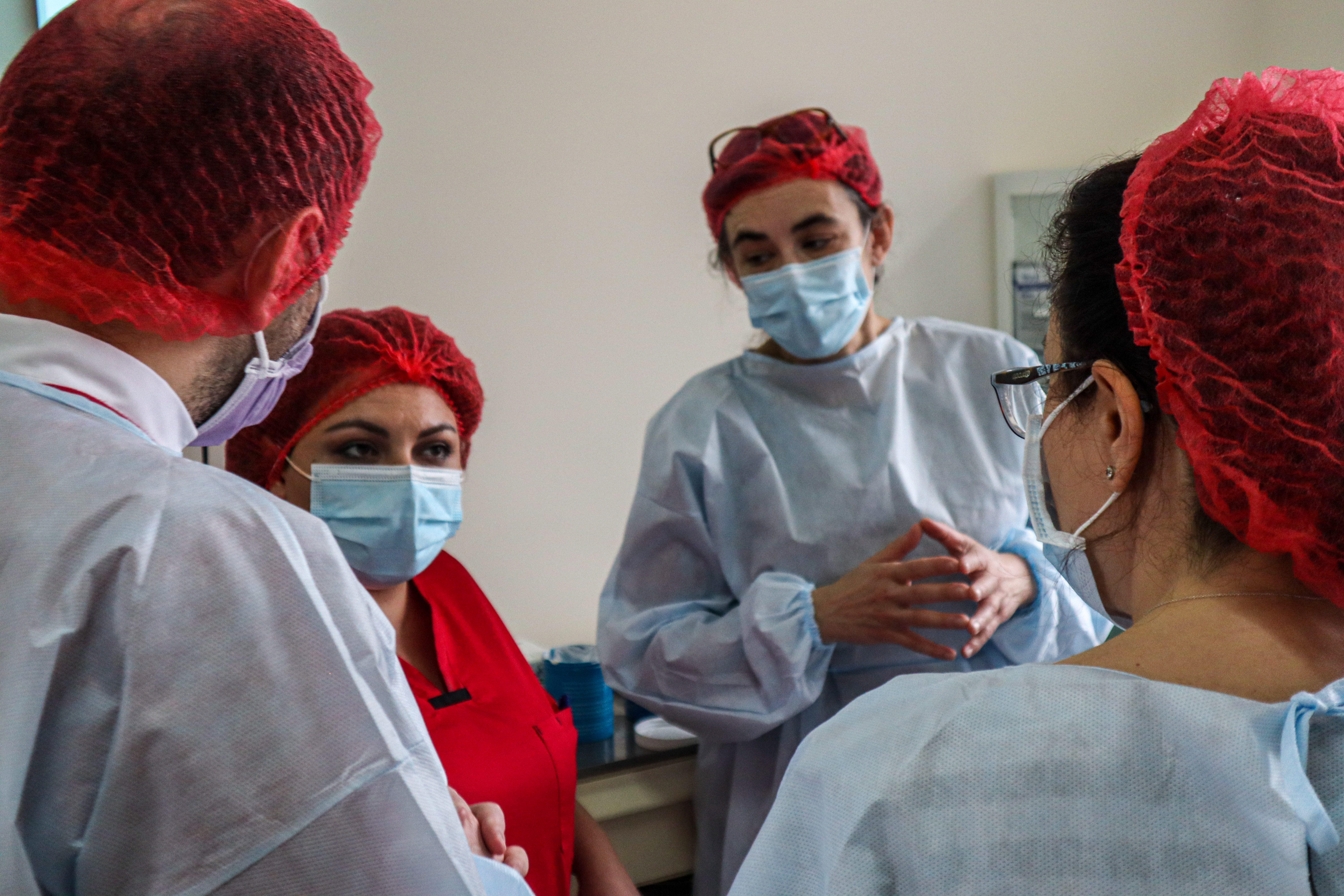
I connected with Tamar Kupeyan, an Armenian-Canadian woman who had been working as a volunteer in Armenia since the war began, collecting donations from the diaspora and distributing them to families in need. One of the families we visited together was a new couple, just married before the war. The husband was now missing his leg and his wife was pregnant. He had been injured by a drone strike in the Jabrayil district, an area now under Azerbaijan’s control. Due to the excess demand for medical care typical of a battlefield hospital, he then had to wait for over 12 hours with no anesthetic before receiving treatment. Even when doing surgeries, anesthesia had to be rationed until foreign aid came in.
The Armenian diaspora is unique in that it is larger than the country itself. The diaspora has a population of around 11 million, while the country itself has just less than 3 million. While many Armenians see the immense influence of the diaspora as a cultural threat to their traditional and conservative mores, the Armenian state would be lost without this satellite patriotism. Repatriation also boosts Armenia’s population, as many diaspora members like Tamar have moved back to Armenia over the years. Even abroad, the diaspora tends to be an incredibly insular group. I observed to Tamar that the Armenians I knew in Toronto tended not to conform much to wider Canadian society; she remarked it was because they were forced out of their country. They didn’t choose to leave, so they remained more attached to their Armenian identity.
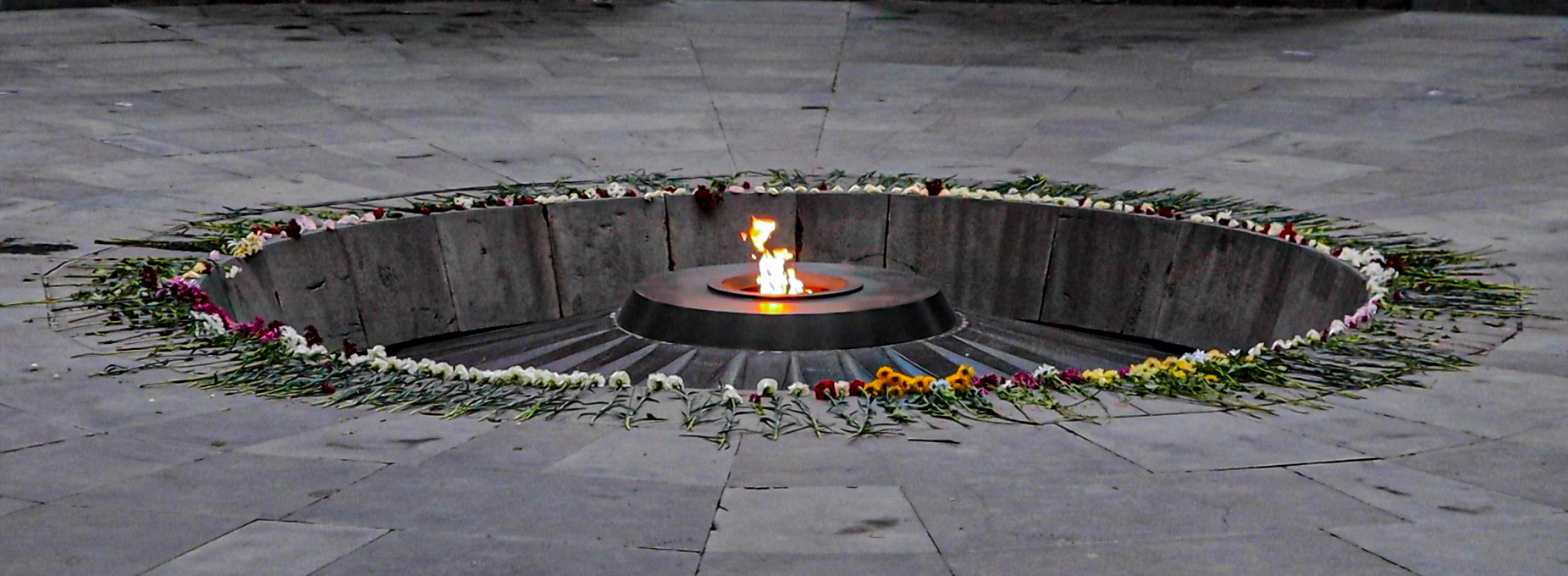
But while Armenia’s welcoming of Western influence in the forms of diaspora repatriation and private capital has benefited the country, Western influence in Armenia’s government has had very different results. The outcome of this war proved that Nikol Pashinyan’s strategy of courting the EU was shortsighted and naive for a country whose security is inextricably tied to a strong Russia.
On May 8th, 2018, the national assembly of Armenia elected Pashinyan as prime minister, and on May 14th, Pashinyan joined Putin in Sochi for a meeting of the Eurasian Economic Union (EAEU) member states, an alliance spearheaded by Russia. Concurrently, Pashinyan was leading Armenia’s Yelq bloc, also called the Way Out Alliance, which was composed of three liberal political parties who were united against the country’s EAEU membership. The coalition saw it not only as a threat to Armenian development, but also to resolving the Artsakh dispute. Following the summit in Sochi, Pashinyan made his agenda clear by appointing several officials with strongly anti-Russian track records and associations to his cabinet.
Of these appointments, the one likely most alarming to Moscow was Armen Grigoryan as head of the National Security Council. Grigoryan was formerly the program coordinator of the anti-corruption NGO Transparency International, an organization funded by the Open Society Foundations. Another appointment by Pashinyan was David Sanasaryan as head of the anti-corruption State Control Service. Ironically, Sanasaryan was charged with operating a corruption scheme that enriched his brother’s firm and was removed from office. Pashinyan’s government is not above the cronyism that characterized the old regime, even though they frequently decry it. Sanasaryan has called for the expulsion of a Russian military base and went so far as to throw eggs at the Russian embassy in Yerevan. Pashinyan also appointed several other cabinet members with Soros ties, which Moscow undoubtedly viewed as a threat.
In July of 2019, Armenia adopted the Comprehensive and Enhanced Partnership Agreement (CEPA) implementation roadmap with the EU, a small but non-trivial increase in their partnership. In October 2019, Armenian deputy prime minister Tigran Avinyan said that Armenia now had a “completely different level of relationship with the EU,” and that in the future, joining the EU as a member state would be “a question that the people of Armenia need to answer.”
Joining the EU would mean relinquishing membership in the Russian-led EAEU. The major stated goal of Pashinyan and his supporters was to root out the incessant corruption of the previous regime. But an antagonized Russia perceived them as courting its enemies, and its response left Armenia stranded among hostile neighbors. Since Armenia heavily relies on Iran for trade and Russia for security, the move risked two of the small country’s most important relationships.
The geography of Armenia dictates who the country can realistically rely on. To the west of Armenia is Turkey. Thanks to Armenia’s membership in the Collective Security Treaty Organization (CSTO), Russia guarantees their defense on this front. To the east is the now-lost buffer zone of Nagorno-Karabakh, followed by Turkey’s client, Azerbaijan. The CSTO never extended to Karabakh, and thus Russia never directly provided Armenia with military support. But the reason Armenians still have a presence there is because Russia finally decided to insert itself in the South Caucasus with this peacekeeping mission. To Armenia’s south is another Western foe: Iran, whose geographic position also means that Armenia is Russia’s corridor to their closest Middle Eastern ally. And to the north is Georgia, which has a permanent Russian presence in Abkhazia and South Ossetia, thanks to its own failed attempt to realign with the West.
Running beneath these complex alignments is a basic question of identity. Is Armenia a Western country, a former Soviet republic, a uniquely Middle Eastern Christian state, or something else entirely? The question divided those I talked to. The Christian identity of Armenia—overwhelmingly Orthodox—naturally aligns it with both Russia and Europe. There’s also a cultural element: everywhere I went, cabbies played Western music, bars had Western-themed decor, and the leading fashion brands were from Western cities. But the case made by Armenia’s pro-Western voices goes beyond religion or pop culture.
For Avetis Muradyan, my fellow Palladium writer, the whole thing was hardly a question. “Armenia is European, and always has been,” he said as we discussed the topic. “Armenia was Hellenized in antiquity. Since then, Armenian culture has always looked to Europe as its point of reference. And it does this to the detriment of its neighbors.” But, I pointed out, dwelling on ancient history like this is practically a requirement for any nation-state. What about its modern culture?
“While Armenia was forming its modern identity—this was from roughly the 18th to the 20th centuries—all major Armenian elites were educated in Europe,” he recounted. “Aivazovsky was educated at Saint Petersburg’s Imperial Academy of Arts; Komitas, the great musicologist who preserved Armenia’s song traditions, was educated in Berlin; Prince Valerian Madatov, when he was a boy, got sent to the court of Catherine the Great. Ironically, that was done by Nagorno-Karabakh’s nobility, and their goal was to bring the Caucasus under Russian rule. Even the first prints in the Armenian language come from Venice.”
History aside, I noted that, during my travels, pro-European sentiments seemed to have a more modern concern. Specifically, they reflected frustration with corruption and a desire for a sense of democratic accountability. “That’s true, and it’s not new,” Avetis replied, “The cultural affinity has always made Armenia a fertile ground for European ideas. In the 19th century, it was romanticism and nationalism. In the 21st, it’s democracy and the rule of law.”
But for others, to laud and encourage the creeping influence of Western culture, governments, and NGOs in Armenia was nothing short of offensive. This view, in my experience, correlated with a greater suspicion of the diaspora’s Westernized influence, and a more socially traditionalist lens on Armenian identity.
“The identities of many European nations were assembled centuries after Armenians had already developed a cohesive language and culture,” said Armen Kaprelian, a local friend and researcher in Armenia’s Ministry of Economy. “Our roots are decidedly distinct from Europe—especially Western Europe. We’re more similar to Persians and Assyrians. On the far end, we’re perhaps even similar to Slavs, Jews, and Kurds.” I asked Armen about the Soviet legacy in Armenia, especially in light of its relationship with Russia and the Eurasian Economic Union. “Most of the notable Armenian intellectuals of the modern era got their education under the USSR. The Armenian SSR was a training ground for many of the top Soviet mathematicians, physicists, engineers, and so on. Some of that generation still runs our universities today, and our best thinkers are products of the Soviet heritage.” I noted that, like Russia, it seemed like many of those people left after 1991. “Unfortunately, after the collapse of the USSR, Armenia experienced a period of brain-drain,” he concurred. “A lot of people fled to Russia or elsewhere. Nowadays, Armenia still has its strongest academic ties to Russia. European and U.S. institutions have started making inroads, but only recently.”
In practice, though, it’s the hard realities of geopolitics and institutional strength which will determine Armenia’s alignment. Corruption, which characterized the old regime, is often seen as synonymous with influence from Moscow. It may not be realistic for Armenia to cozy up to the West, but pro-European voices can point to the dangers of state stagnation as a worse alternative.
While Russian dominance of Armenia’s domestic political affairs is unavoidable in the short-term, the reality is that Russia is in a precipitous long-term decline. Russian foreign policy in the last two decades has spread Russian forces thin across several fronts and mainly achieved residual or symbolic victories. Its ostensible victory in Syria has yielded only a small sliver of land on the coast of the Mediterranean, where they now have a militarily obsolete naval base surrounded by NATO navies. Russia’s invasion of South Ossetia and Abkhazia has rendered Georgia permanently hostile to it. Georgia now functions as a Turkish satellite that hosts the oil and gas pipelines between Azerbaijan and Turkey. Ukraine, another former Russian satellite, has been permanently lost to Western influence, with nothing more than a frozen conflict and an increasingly hawkish NATO to show for it. While the victory in Crimea is more useful than Russia’s other interventions, it may also be the cap of Russia’s expected gains in the region. Putin has a legally and politically secure position for the foreseeable future, but it’s not at all clear whether a competent successor will come to the fore.
The problem for Armenia’s pro-European factions is that Russian decline may be underway, but Russian collapse certainly isn’t. Culturally, the country has recovered a degree of cohesion and resilience. The recent unrest catalyzed by the arrest of Alexei Navalny, the chief opposition leader to Putin, could form clusters of insurrection. But the Kremlin seems basically able to crush these, and willing to endure the feedback loop of unrest. The West mainly expresses its hawkish tendencies toward Russia through sanctions, not military power. Russia might not be strong enough to dominate for the next hundred years, but it certainly seems able to handle the next decade.
For the moment, the question is whether it’s committed to staying. With Russian peacekeeping forces spread thin across many fronts—Libya, Syria, Ukraine, Georgia, and now Artsakh—this could be the first time that a Russian peacekeeping presence doesn’t become permanent. That would mean disaster for the remnants of Artsakh. And with no nominally pro-Armenian Western power realistically stepping in, that leaves Russia as the least-worst option for many Armenians, for whom the real threat is Azerbaijani expansion backed by Turkish military aid.
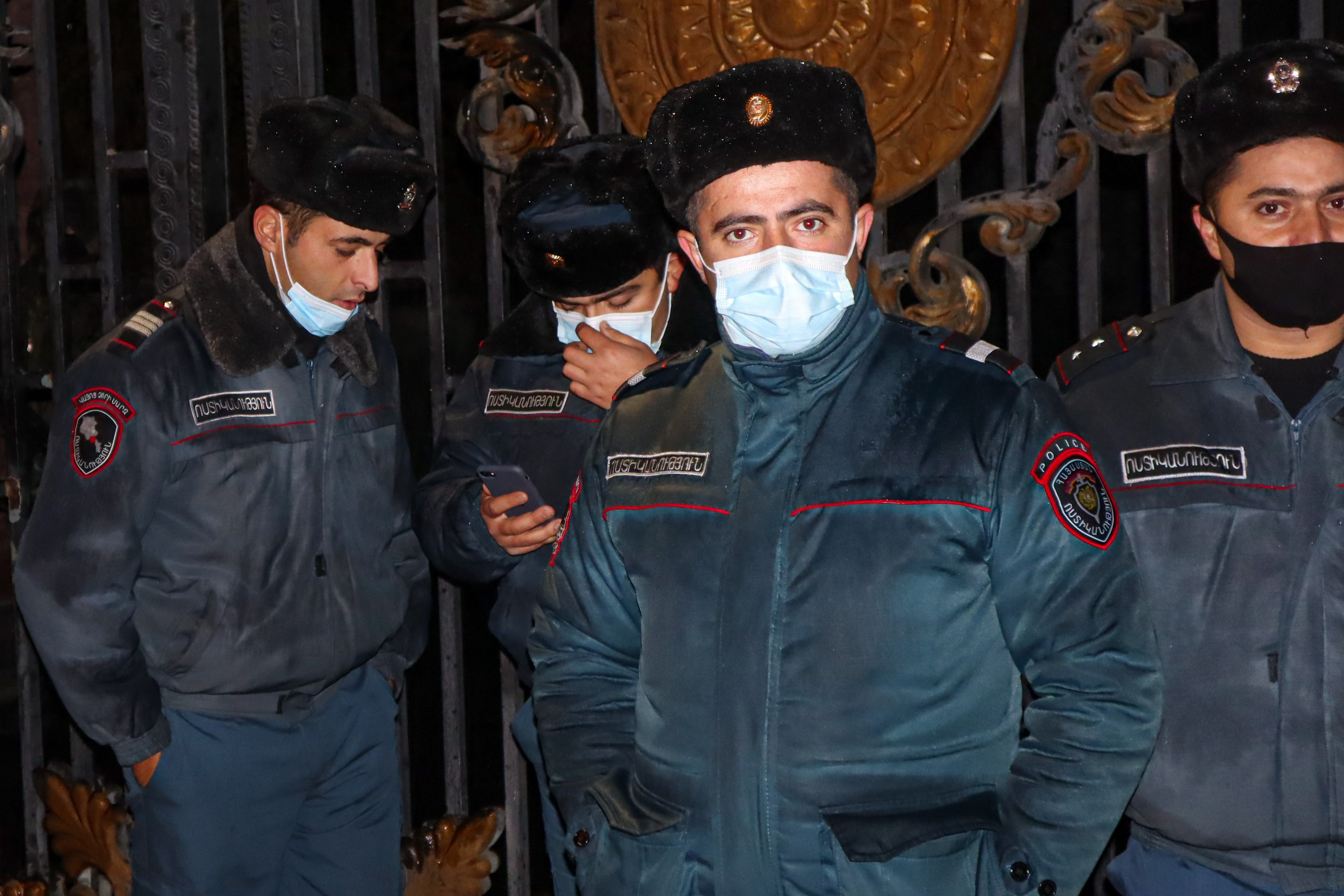
Azerbaijan and the Rise of Turkey
On December 11th, Azerbaijan held a victory parade in its capital of Baku, which was attended by Erdogan and members of the Turkish armed forces. In his speech, Erdogan praised the spirit of Enver Pasha, the powerful Ottoman general who was also the architect of the Armenian genocide: “Today, may the souls of Nuri Pasha, Enver Pasha, and the brave soldiers of the Caucasus Islam Army, be happy.” For his part, Azerbaijani President Ilham Aliyev claimed the Armenian capital of Yerevan to be their historical lands: “During the war, I said that our iron fist embodies both our unity and strength. That iron fist broke the enemy’s spine and crushed the enemy’s head. After that, if Armenian fascism ever raises its head again, the result will be the same.”
Adding to the list of provocations was a set of postage stamps Azerbaijan released on January 12th, depicting the fumigation of Karabakh. While Azerbaijan claims that this hybrid of soldier and exterminator is a testament to both the country’s fight against COVID-19 and Armenia, the symbolism is not lost on either Armenia or the Azerbaijani public. One Azerbaijani Twitter user posted a photo of the stamps with the caption, “If a cockroach was born in the kitchen, this does not mean the kitchen belongs to him.”
The stamp’s graphics show this fumigation happening in the southern Armenian province of Syunik. Syunik is a critically important strategic area both for Russia and Turkey. For Russia, it is their direct access path to Iran. For Turkey, it is their missing link into Azerbaijan, and then past the Caspian Sea into Central Asia, and ultimately China. This also makes the route valuable to China’s ongoing Belt and Road Initiative. But the strategic relevance of the location may prove Azerbaijan’s undoing as well. Despite Aliyev’s bombastic talk of Azerbaijani power, the fact is that his decisions increasingly need approval in Ankara. I discussed Azerbaijan’s victory with Eric Hacopian, an Armenian-American consultant who explained that Azerbaijan had given up a large degree of autonomy to reclaim this territory: “Aliyev’s victory is at the price of having two worms in his apple: Russia and Turkey. And both have a much larger appetite than him.”
Azerbaijan’s regime is a semi-hereditary affair, at least unofficially. In 2003, Ilham Aliyev was elected president of Azerbaijan following the death of his father, then-President Heydar Aliyev. The Aliyev dynasty has been in firm control of the country since 1993, when Heydar Aliyev was elected president following a referendum to end the brief one-year rule of Abulafaz Elchibey and his party, the Popular Front of Azerbaijan. Heydar Aliyev had been governing the Nakhchivan Autonomous Republic—an Azerbaijani exclave which is separated from the rest of the country by Armenia—without interference from the mainland government in Baku since 1991. In 1993, Armenian forces captured Shushi—called Shusha in Azerbaijani, and the last Azerbaijani-populated stronghold in Nagorno-Karabakh at the time. Following his election, the elder Aliyev was forced to sign a ceasefire which fully surrendered the mainly Armenian region of Nagorno-Karabakh, along with seven surrounding provinces. Together, they constituted the inception of the independent Republic of Artsakh.
While Azerbaijan’s ostensible motivation for retaking Karabakh was reclaiming a traditional and sacred cultural land, the establishment of new lucrative trade routes was excellent leverage for the country to gain support from its key allies. On January 11th, Pashinyan and Aliyev joined Putin in Moscow for the first time since the war started to discuss the future of the region. They came away signing a joint statement, which included an agreement to establish new trade links.

Turkey will now be directly connected to Azerbaijan through Nakhchivan and the Syunik province, via a transport corridor agreed on in the November 9th peace agreement. The corridor will go through the south of Karabakh, across the lands captured during the war. Another railway will connect Armenia and Russia to Iran, with Russia passing through Baku and circumventing Georgia. The new corridors will benefit Russia immensely. Georgia is the notable loser, but Iran hasn’t gotten a great deal either. In the long-run, Turkey and Azerbaijan aim to decrease the reliance they had on trading through Iran while the conflict went on. In the new regional order, they can now go through the Syunik province of Armenia and through Nakhchivan.
Since taking power in 2003, the younger Aliyev has been very successful in building up the Azerbaijani state by forming relationships and maintaining leverage over several world powers who are competing against each other. Despite having a security pact with Armenia, Russia is still very much intent on maintaining influence in Azerbaijan—hence their establishment of a new trade route that passes through Baku, and the sale of weapons to Azerbaijan. Azerbaijan also sells a large amount of natural gas to Israel, which offers them weapons in return.
A year after Aliyev took office in 2004, Azerbaijan became part of the EU’s European Neighborhood Policy, which looks to include eastern and southern neighbors in Europe’s orbit. While Armenia is also part of this policy, Azerbaijan has been able to form closer ties with the EU by creating a gas pipeline called the Southern Gas Corridor, which passes through Georgia and Turkey, and directly competes with Russia in the European gas market. This project was finally completed on the last day of 2020. Azerbaijan’s strategy of containing its enemies by making them friends is similar to that of other Eurasian states; Kazakhstan, for example, has China, Russia, and the United States all leveraged in its favor via its oil and minerals. Armenia simply isn’t able to exert the same amount of leverage as Azerbaijan or Kazakhstan over its neighbors because Armenia’s natural resources pale in comparison to Azerbaijan’s oil and gas, which make up 90% of the country’s total exports.
On January 7th, Aliyev lamented a visit to Stepanakert—called Khankendi in Azerbaijani—by the Armenian foreign minister as a “provocative step,” and to remember that “[our] iron fist remains in place.” He also declared, “The whole world recognizes this territory as an integral part of Azerbaijan. No foreign citizen can enter this zone without our permission.” The first part of his statement is true; Karabakh is an internationally recognized territory of Azerbaijan, and Armenia is seen to have occupied the territory for over 30 years.
But it isn’t true that people need permission from Baku to enter the territory. The very Russian peacekeeping operation which helped make his comments possible is now the main enforcer in the region. The November 9th peace deal stipulated that Azerbaijan must allow safe passage for Armenians to Stepanakert via Lachin. There was never any thought of needing to acquire permission from Baku. I was given permission by the Artsakh Ministry of Foreign Affairs, and by the Russian peacekeepers who let me through the checkpoints.
The Road Into Artsakh
While driving towards Nagorno-Karabakh, we hugged the northern border of Nakhchivan while traveling east towards the Lachin corridor, which is now the only way to enter the region from the Armenian side. When there isn’t a mountainside directly adjacent to the highway, it is protected by a prolonged barrier of earth, with intermittent sniper positions that peer into Nakhchivan. The strange border demarcations of Armenia and Azerbaijan, with little patches of one country within the other, are a reminder of the many unresolved conflicts between the two nations, who increasingly see each other’s annihilation as indispensable to their own survival. But Armenia is deeply traumatized from this war, merely hoping they can maintain the already disastrous terms of the peace deal, while Azerbaijan’s appetite for Armenian land seems boundless.
The Lachin corridor is a treacherous path of nearly 40 miles from Goris to Stepanakert, which passes through newly captured Azerbaijani territory in the Shushi region. It is named after the town of Lachin, the last population center one encounters before making the steep ascent into mountainous Karabakh. The town is also referred to as Berdzor, an Armenian name, while Lachin is Turkish. The names of many of these places change when the territory itself changes control.

To make the journey, I needed press accreditation and a special visa for the region. After clearing those hurdles, I asked my contact in Artsakh’s Ministry of Foreign Affairs if I could accompany a group of refugees returning home from Yerevan to Stepanakert with a Russian military escort. Armen Kaprelian, my economist friend, offered to make the trip with me. His perfect English made him an indispensable companion.
Unfortunately, the government had given us bad information about the convoy’s departure, and we eventually decided to make our own way to Stepanakert. Our driver, who asked that his name be omitted, had made this treacherous, winding journey along the Lachin Corridor since the beginning of the war. When the war still raged hot, he drove the route with his lights out to avoid drone strikes. Though that period is technically over, the shooting has not really ended. It continues along disputed land demarcations and rebel holdouts, which are finally being weeded out by Azerbaijan. The cost of our journey was 40,000 Dram, or nearly $80 USD. That would be enough for someone in Armenia to pay all their monthly utility bills.
When entering the Lachin corridor, there used to be a sign with the red, orange, and blue Armenian tricolor flag. That has now been replaced with the red, white, and blue of the Russians, indicating that for all intents and purposes, this area is under Russian control. When arriving in Stepanakert, the capital of Artsakh, the Russian flag is seen just as often as the Artsakh flag. The checkpoints were a breeze–we had all the right paperwork, and our driver was a regular.
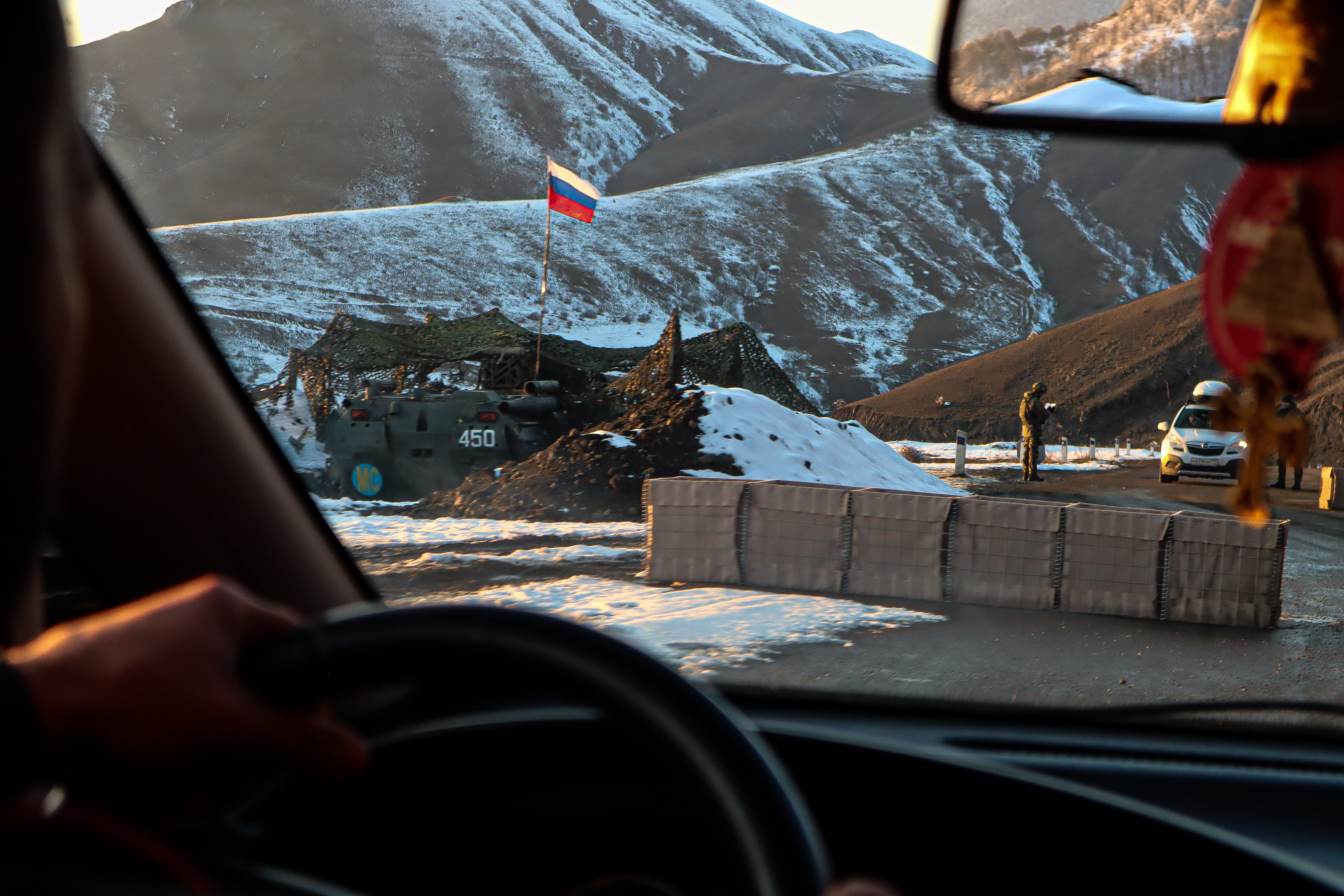
But what makes this drive so risky is that in order to access what is left of Artsakh, you have to pass through newly captured Azerbaijani territory. I asked our driver about encountering Azerbaijanis or any Turkish presence on this route, and if he was armed just in case. He pulled out a large knife from the crack between his seat and gear shift where I usually lose my phone. The bit of Azerbaijani territory you need to pass through is in the Shushi region, right before Stepanakert. Shushi is a fortress that sits on top of a mountain overlooking Stepanakert, and as such is a strategically important city. Stepanakert in turn is highly susceptible to artillery barrage because of its valley location.
In Armenian journalist Garin Hovannisian’s book Family of Shadows, he talks about a time when his father, the first Armenian foreign minister, visited Shushi in 1987: “A couple of frightened Azerbaijani boys were running away from the camera, but my father was following them. ‘This is Shushi, my boys, there are no Armenians here. But one day, one day, the Armenians will come.'” The city is known as the beating heart of Karabakh and has traded hands several times throughout the centuries. In 1920, Armenians were expelled; in 1992 it was the Azerbaijanis. This year, it was Armenia’s turn once again. Since the end of the war, Pashinyan has stated that Shushi was a majority Azerbaijani stronghold prior to the first Nagorno-Karabakh war, and that it was a miserable and neglected place. Such statements have fueled accusations of Pashinyan betraying Armenia, and there are many reports that Armenian forces were told to retreat from the city despite having managed to hold it. Back in Yerevan, protests include thundering chants of “Nikol Davachan!”, meaning “Nikol the traitor.”
When passing through Shushi, my driver told me not to take pictures of the Azerbaijani soldiers, who he then proceeded to curse out as we drove by. The stalemate at this checkpoint shows how the war is still completely unresolved, and the new border demarcations are absolutely unsustainable. This was confirmed a few days after the peace deal by Putin: “The Karabakh question still hasn’t been answered.” While Azerbaijan is nominally in control of Shushi, Russia has established a military base there, and the peace deal stipulates that Azerbaijan must allow Armenians to travel through the region unharmed. This is necessary for anyone wanting to access Stepanakert and the rest of Armenian-populated, Russian-controlled Karabakh, which stretches to the eastern Martuni region. Despite formally being in the hands of Azerbaijan, Russian peacekeepers control all the access points to Shushi, and everyone I spoke with in Artsakh seemed to think it wouldn’t be in Azerbaijani control for long, as Russian forces could starve the city of resources or take it by force. But while Russia surrounds Shushi, Azerbaijan surrounds Russia.
Only a few years ago, a new road was built which connected Armenia to Artsakh through the northern Kelbajar region, a path which rivals the beauty of the Swiss Alps. But that territory was ceded to Azerbaijan in the November 9th peace deal. Azerbaijan was unstoppable in its campaign in the southern part of Karabakh, which ended once it captured Shushi on November 8th. Despite Armenia being able to hold its own in the north, it was still forced to relinquish control of these territories. This means that the Russian peacekeeping presence, as well as the Armenians still living in Artsakh, are surrounded by Azerbaijani forces.
Once in Artsakh, we took the long way from Stepanakert to Martuni and gazed at Shushi across the valley. From a distance, the steeple of the historic Ghazanchetsots cathedral could be seen. Local Armenians have accused the Azerbaijanis of desecrating it; Azerbaijan, whose soldiers barbecued in the church following its capture, won’t allow UNESCO to inspect it. Adjacent to Shushi, Stepanakert could be seen sitting in the valley. Looking down upon the city, it was now obvious to me why Artsakh’s capital is such a vulnerable military target.
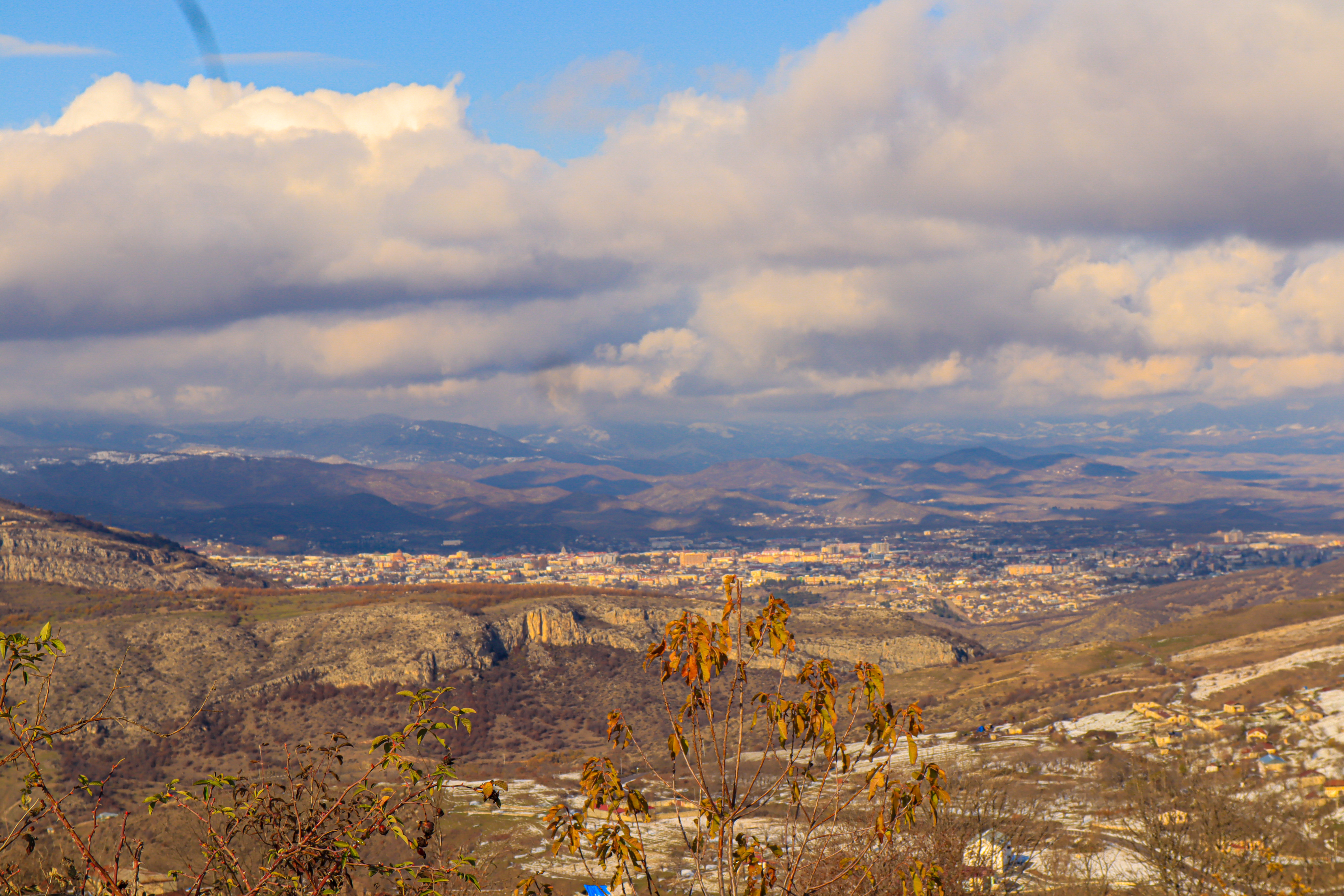
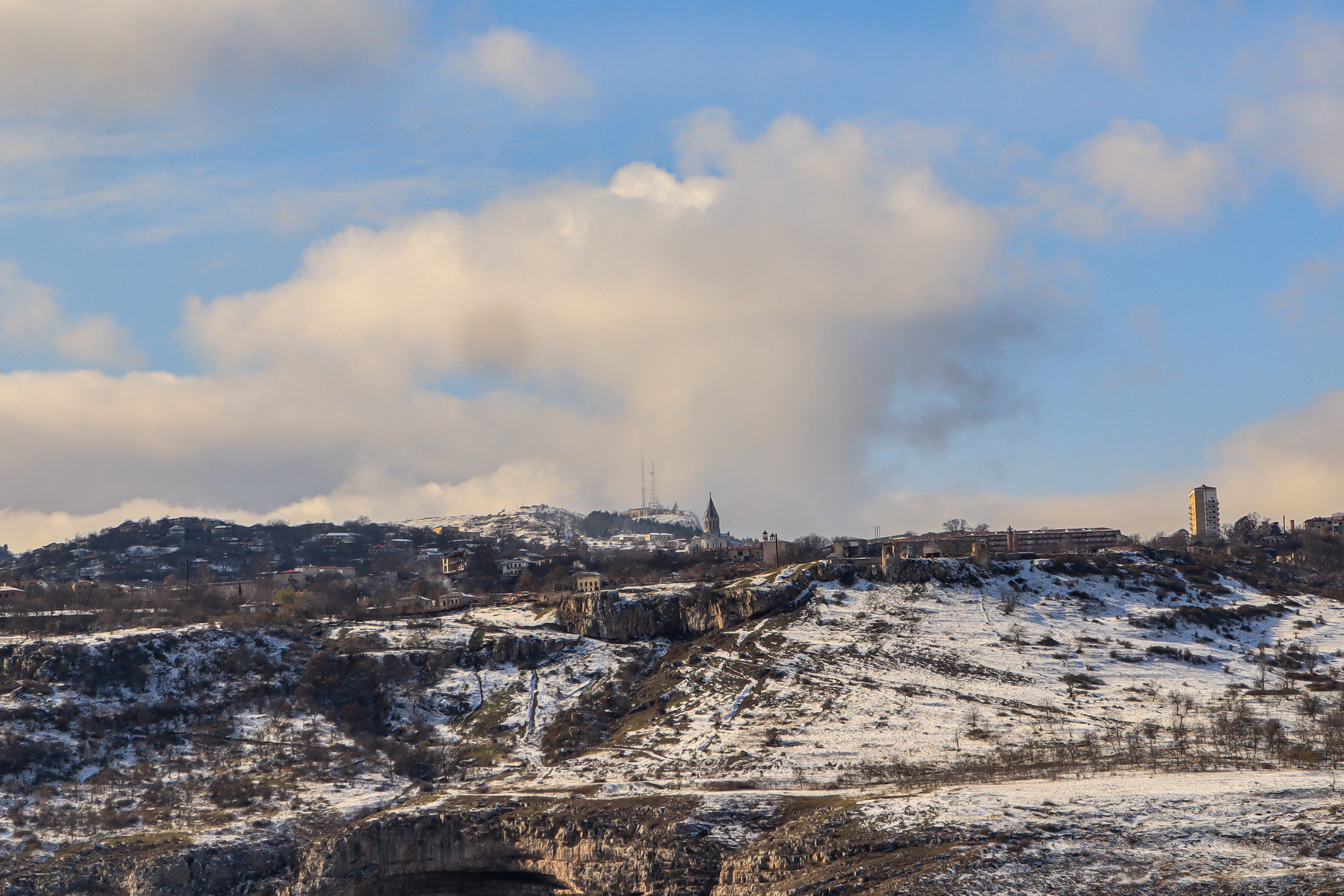
The remnants of Armenian-controlled Karabakh stretch from Stepanakert to the eastern village of Martuni, which is less than 6 miles from the border with Azerbaijan. The damage in Martuni was extremely widespread.
As our new driver hadn’t been to Martuni since the war began, we paid a visit to his sister and her family. All the windows in her house had just been replaced after being blown out from the shelling, a common result of artillery attacks. Despite the travails of living in a war zone, they remained cheerful and extended gracious hospitality. The stoicism of the villagers was impressive given the circumstances.
We talked to some other villagers as well. One man directed us to a cratered-out home that had suffered a direct hit. An excavator was needed to find the body of his neighbor.
Another woman had fled her home, only to return to it as mostly rubble. She hadn’t lost any family in the war, but her son was injured, and he was at that time in a hospital in Goris. Unfortunately, she had recently taken out a loan on this property and still had to repay it. In total, 13 villagers who couldn’t escape in time were killed by Azerbaijani shelling in Martuni.

The further I traveled into the region, the more vitriolic and distrustful Armenians were of Pashinyan. Somewhere between Stepanakert and Martuni, we pulled over to speak with some soldiers who had fought in the war. Both had been injured, and neither were fans of the prime minister. “Fuck Pashinyan!” declared one. “Pashinyan is like a balloon,” the other quickly followed up. “If you blow, he flies away.” These soldiers hadn’t lost their homes, but they were now surrounded by Azerbaijanis.
Pashinyan supposedly signed the peace agreement under duress and has consistently laid blame on the previous regime for neglecting Armenia’s armed forces. In reality, neither government procured the appropriate military equipment to challenge Azerbaijan, which despite spending half as much as Armenia as a percentage of state expenditures, spent nearly four times more in dollar terms in 2020. I talked with Matthew Winchester-Arlow, an open-source intelligence analyst who posts most of his work on Instagram: “Azerbaijan acquired drones, Sandcat APCs, and loitering munitions, while Armenia wasted money on the Su-30SM fighter jets that they didn’t have munitions for and which took the place of anti-aircraft defenses,” he explained.“Even their military tactics reflected outmoded Soviet-era doctrine. Problem was, they didn’t have the support structure of the actual USSR which those tactics assumed.”
Mistakes of the past regime aside, Pashinyan was in charge when the war broke out, and his government mismanaged the Armenian armed forces throughout it. Colonel-General Movses Hakobyan resigned his position as head of the Military Control Service on November 19th, issuing a statement alleging that by October 30th, only 72% of Artsakh’s military and 52% of Armenian reservists had been mobilized. This meant that approximately 200,000 Armenian soldiers were not deployed to the frontlines. A leaked Collective Security Treaty Organization (CSTO) intelligence report showed that Pashinyan’s government was warned in advance of an imminent attack from Azerbaijan, and chose to ignore it. These discoveries have resulted in growing anger at the Armenian government’s failures, and at perceived traitors in Armenian institutions, including the military.
When returning to Armenia proper on the Lachin corridor, we were confronted by the reality of travel in a warzone. As we drove through newly captured Azerbaijani territory just south of Shushi, a nondescript van parked at the side of the road pulled out as we passed and began to trail us. We wondered aloud what reason it might have for following us. Our driver—the same who had brought us into Artsakh—stared into the rearview mirror. “They look like Turks,” he said under his breath, and hit the gas. Our unwanted companions kept pace. Luckily, we were just a couple kilometers from a Russian checkpoint. As we approached, the van backed off. Our driver pulled up and told the guard what had happened, demanding that he question the driver and prevent any Turks or Azerbaijanis from entering Armenia. From behind us, I could see the van approaching the checkpoint with its hazard lights flashing. The peacekeeper stepped into the road to confront it. We didn’t stick around to listen in. Taking advantage of the extra time, we sped off towards the safe territory of Armenia proper.
Given that we were so close to a Russian checkpoint, a planned attack seemed unlikely. The Russians have made the threat of mortal danger a very small possibility since they established jurisdiction of this route. But our mysterious followers certainly wanted to announce their presence, and in a decidedly unfriendly manner. The ceasefire agreement requires Azerbaijan to provide a safe passageway for Armenians to and from Artsakh through the Lachin Corridor. Perhaps the goal of our followers was to discourage anyone from making the trip, regardless of what the peace deal might say.
If successful, such tactics could slowly cut off Artsakh from Armenia, since the survival of what remains of Armenian Nagorno-Karabakh now depends entirely on this one dangerous overland route. A new road has been promised by the peace deal which circumvents Shushi, but there is no expectation as to when it will be finished.
While Armenia has suffered a massive defeat, the new trade routes may end up being the first step to normalizing relations with Azerbaijan and generating capital inflows. A mutually beneficial trade agreement might be the only way that Armenia and Azerbaijan can cooperate in the future. But these new railways might just as easily be used to facilitate an arms race for the next war. Whether in the Syunik province or in Nagorno-Karabakh, another war is inevitable—likely in both regions, but certainly in the latter.
What comes next for Armenia is a decision between Western-style democracy or immediate security. Armenia will, at the very least, be a vassal of Russia for the foreseeable future. Its choice is whether to do so begrudgingly or to fully accede to Russian power as a core part of its survival strategy. Given Russia’s potential long-run decline, this may end up a geopolitical devil’s bargain. Armenia would secure its immediate position, but only for so long as Russia remains willing and able to involve itself in the region. Should that change, Armenia may end up even weaker in the long-run, and surrounded by even bolder and more powerful enemies than it is now. Despite the heavy cost, the immediate survival of the Armenian state is likely preferable to being dominated by Turkey and its allies. Just like the end of the first Nagorno-Karabakh war, the current peace deal has only brought about more questions than answers. The direct involvement of Russia and Turkey makes this stalemate even more precarious and convoluted than the first.
Going forward, there will be some tentative peace and continued diplomatic negotiations. Armenians in Artsakh will continue to live in this Russian-controlled and Azerbaijani-surrounded enclave in Karabakh, but many see the writing on the wall and are fleeing to safe havens such as Yerevan or Tbilisi. Russian peacekeepers will regain control and guarantee the protection of this dreary territory—likely for the next 5 years, as that is the initial agreement for Russia’s peacekeeping operation. However, Artsakh may hold the unenviable accolade of being the first territory where Russia pulls out of a peacekeeping mission, deciding it isn’t worth it to stay surrounded indefinitely. When the parties involved have fully exhausted diplomatic options, the table will be set for the next war. In many ways it already is. There are far too many tripwires, with no way to disarm them.
